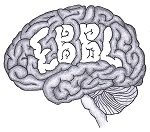In my first blog post, I talked about brain regions that showed functional differences between people with social anxiety disorder (SAD) and those without. Although this broad point of view is certainly interesting and useful, it made me want to further explore how these functional differences may come into play as people live their lives and encounter various stimuli in the world they live in. Why is it that although a socially anxious person and a non-socially anxious person may be encountering the same social situations, they react so differently to them? Specifically within the context of this class, what are the differences in how their brains are processing these situations?
Conceptually, researchers have thought of anxiety in the context of the fear response. Unsurprisingly, the stimuli implicated in that fear response that most SAD researchers are interested in are emotional facial expressions. Since one of the defining features of SAD is anxiety about being criticized or rejected by others, it intuitively makes sense that those with SAD would be hypersensitive to harsh or threatening facial expressions.
To determine whether this intuition holds up in the lab, many studies have compared SAD patients and healthy controls in how they process images of various facial expressions. Phan and colleagues (2006) simply showed subjects standardized photographs of angry, fearful, disgusted, sad, neutral, and happy faces, and examined amygdala activity in response to these faces using fMRI. Not only did they find increased right amygdala activation in SAD patients compared to healthy controls in response to aversive faces (angry, fearful, disgusted), these increases were significantly positively correlated with social anxiety symptoms. Similar differences in right amygdala activation were also found in studies utilizing schematic faces (line drawings), further strengthening these findings by minimizing possible confounding effects of gender, race, or age that might emerge in studies that use photographs (Evans, Wright, Wedig, Gold, Pollack, & Rauch, 2008).
Taking these findings into account, think of the following social situation that Alice, who has been diagnosed with SAD, finds herself in. Alice’s SAD often makes her avoid situations that involve giving presentations, especially those that involve presenting to one specific executive in the company, Anne, who always seems to look angry. Her coworker Joe usually covers these presentations, however Joe has to call in sick on the day of an important presentation that cannot be delayed. Alice, being the only other person qualified to present their project, finds herself standing in front of a handful of interested-looking executives from their company. However, the crowd also includes Anne. How might Alice’s brain act in this situation?

This is what Anne looks like most of the time.
If you asked this question to researchers, they might refer you to the vigilance-avoidance hypothesis (Mogg & Bradley, 1998), which suggests that SAD is characterized by faster detection of threatening emotional expressions and subsequent avoidance these threatening cues. In their 2004 study, Mogg et al. found support for this theory by using a visual dot-probe task with photographs of angry, happy, and neutral faces. In this task, pairs of faces were presented simultaneously, and immediately after this presentation, a probe stimulus appeared in the location of one of the faces. Participants were asked to respond to the probe. Faster response times to the probe indicated higher vigilance to the image that the probe took the place of. Their results indicated that people with SAD showed enhanced vigilance for angry, relative to happy and neutral faces, after a short (500 ms) exposure to the images. However, they found that this effect disappeared after a longer (1250 ms) exposure to the images, supporting the vigilance-avoidance hypothesis.
What have researchers done with these initial results, you may find yourself asking. To answer this question, in my remaining blog posts I will first review some (more recent) literature that examines the mechanisms that comprise and mediate the threat-relevant attentional biases I reviewed here. This will help us understand why these biases might exist. I will then take a look at trainings and therapies that target these biases, and their effects on brain function. Stay tuned!
References:
Evans, K. C., Wright, C. I., Wedig, M. M., Gold, A. L., Pollack, M. H., & Rauch, S. L. (2008). A functional MRI study of amygdala responses to angry schematic faces in social anxiety disorder. Depression and Anxiety, 25, 496–505. doi:10.1002/da.20347
Mogg, K., & Bradley, B. P. (1998). A cognitive-motivational analysis of anxiety. Behaviour Research and Therapy. doi:10.1016/S0005-7967(98)00063-1
Mogg, K., Philippot, P., & Bradley, B. P. (2004). Selective attention to angry faces in clinical social phobia. Journal of Abnormal Psychology, 113, 160–165. doi:10.1037/0021-843X.113.1.160
Phan, K. L., Fitzgerald, D. a, Nathan, P. J., & Tancer, M. E. (2006). Association between amygdala hyperactivity to harsh faces and severity of social anxiety in generalized social phobia. Biological Psychiatry, 59(5), 424–9. doi:10.1016/j.biopsych.2005.08.012
[Woman with angry expression]. Retrieved October 23, 2014, from: http://images.parexcellencemagazine.com/stories/wisdom_and_wellbeing_articles/woman-with-angry-expression.jpg
